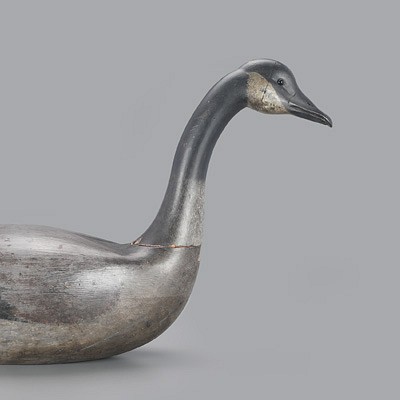High-Head Mallard Pair by Walter "Tube" Dawson (1882-1955)
Lot 201
About Seller
Copley Fine Art Auctions
20 Winter Street
Pembroke, MA 02359
United States
Copley Fine Art Auctions is the world's leading American sporting art auction company. Located in Hingham, MA, Copley specializes in antique decoys and 19th- and 20th-century American, sporting, and wildlife paintings. Principal Stephen O'Brien Jr., a fourth-generation sportsman with a refined colle...Read more
Estimate:
$10,000 - $20,000
Absentee vs Live bid
Two ways to bid:
- Leave a max absentee bid and the platform will bid on your behalf up to your maximum bid during the live auction.
- Bid live during the auction and your bids will be submitted real-time to the auctioneer.
Bid Increments
| Price | Bid Increment |
|---|---|
| $0 | $50 |
| $1,000 | $100 |
| $2,500 | $250 |
| $5,000 | $500 |
| $10,000 | $1,000 |
| $25,000 | $2,500 |
| $50,000 | $5,000 |
About Auction
By Copley Fine Art Auctions
Jul 13, 2023
Set Reminder
2023-07-13 10:00:00
2023-07-13 10:00:00
America/New_York
Bidsquare
Bidsquare : The Sporting Sale 2023, Day 1
https://www.bidsquare.com/auctions/copley/the-sporting-sale-2023-day-1-12989
Lots 1-243 Copley Fine Art Auctions cinnie@copleyart.com
Lots 1-243 Copley Fine Art Auctions cinnie@copleyart.com
- Lot Description
High-Head Mallard Pair
Walter "Tube" Dawson (1882-1955)
Putnam, IL, c. 1920
17 in. long
Dawson learned carpentry from his father and began carving decoys at age seventeen. Over his long career in wood, he proved to be a diverse maker. In addition to these standout high-head models, he made imaginative preeners, a mechanical goose, flying mallards, duck calls, and boats.
Hunting was his passion, and from 1905 until 1918 Dawson took full advantage of the then legal market shooting of the region’s plentiful waterfowl. On Lake Senachwine, he served as a hunting guide to hotel guests.
The distinctive style seen here resulted in his being known as “Tube” among decoy enthusiasts. The high heads, like on the Kankakee pintails, have been attributed to application in tall marsh grasses. These decoy are quite rare with only six believed to have survived.
Original paint with moderate gunning wear, working paint from the waterline down on the drake. Hen has tight neck crack, age line at left crown, and working paint to grey on very bottom. Both have some flaking.
Provenance: Masterworks of the Illinois River Collection
Literature: Stephen B. O'Brien Jr. and Julie Carlson, "Masterworks of the Illinois River," Boston, MA, 2005, p. 108, exact pair illustrated. Zac Zetterberg, ed., “American Decoy: The Invention,” Peoria, IL, 2020, p. 57, exact pair illustrated. Alan G. Haid, "Decoys of the Mississippi Flyway," Exton, PA, p. 168, related pair illustrated. Gene and Linda Kangas, "Decoys: A North American Survey," Spanish Fork, UT, 1983, p. 246, pl. 377, rigmate pair illustrated. Exhibited: Peoria, Illinois, “American Decoy: The Invention,” Peoria Riverfront Museum, February 9–April 28, 2019. Salisbury, Maryland, “The Illinois River Meets the Chesapeake,” Ward Museum of Wildfowl Art, September 2 - November 13, 2005.Please email condition report requests to colin@copleyart.com. Any condition statement given is a courtesy to customers, Copley will not be held responsible for any errors or omissions. The absence of a condition statement does not imply that the lot is in perfect condition.Condition
- Shipping Info
-
Copley does not offer in-house packing or shipping. For clients who require shipping, please complete the Shipping Release Form and return it with your payment. The form includes a list of shippers we frequently work with.
-
- Buyer's Premium



 EUR
EUR CAD
CAD AUD
AUD GBP
GBP MXN
MXN HKD
HKD CNY
CNY MYR
MYR SEK
SEK SGD
SGD CHF
CHF THB
THB














